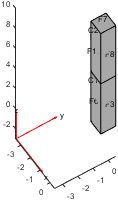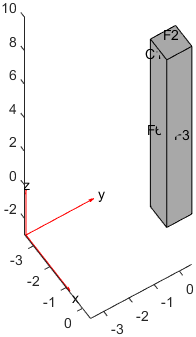Matlab PDE工具箱非均匀材料的处理方式
如何处理非均匀的材料
在Matlab PDE工具箱中,非均匀材料的处理非常简单。这里可以分两种情况来讨论。第一种情况,计算与可以分为多个区域,每个区域有不同的材料属性。第二种情况,计算域中材料属性是连续变化的。
一般而言,用有限元处理的偏微分方程远没有有限差分那么有意思,哦,不对,是没那么恶心。
有限元的复杂,我觉得多半在材料特性上。
按区域设定材料
我们先假设一个传热的例子,计算域中包含两个区域,每个区域有不同的材料属性。
在进行几何建模时,我们就应该分别建立两个几何域来组成计算区域。

1% 几何建模
2length = 10;
3gm = multicuboid([1, 1],[1, 1], [length * 0.5, length * 0.5], 'Zoffset', [0, 0.5*length]);
4
5pdegplot(gm, 'CellLabels', 'on', 'FaceLabels', 'on');
6
7view(57, 56);
8exportgraphics(gcf, 'heatTransferInNonUniformPod.png', 'Resolution', 60);
从这里可以看到,两个Cell(分别是C1和C2)组成了整个计算域。
在材料建模时,我们分别对C1和C2进行材料建模。
1% 材料建模
2material1 = materialProperties("ThermalConductivity", 1, "MassDensity", 1, "SpecificHeat", 1);
3material2 = materialProperties("ThermalConductivity", 100, "MassDensity", 1, "SpecificHeat", 1);
4
5model.MaterialProperties(1) = material1;
6model.MaterialProperties(2) = material2;
在设置完之后,我们可以查看材料属性。
1>> model.MaterialProperties
2ans =
3 1x2 materialProperties array
4
5Properties for analysis type: thermalTransient
6
7Index ThermalConductivity MassDensity SpecificHeat
8 1 1 1 1
9 2 100 1 1
从这里可以看到,C1和C2的材料属性分别被设置为1和100。
最后,按照正常步骤求解即可。

1% 非均匀材料的热传导问题
2
3
4model = femodel("AnalysisType","thermalTransient");
5
6% 几何建模
7length = 10;
8gm = multicuboid([1, 1],[1, 1], [length * 0.5, length * 0.5], 'Zoffset', [0, 0.5*length]);
9
10pdegplot(gm, 'CellLabels', 'on', 'FaceLabels', 'on');
11
12view(57, 56);
13exportgraphics(gcf, 'heatTransferInNonUniformPod.png', 'Resolution', 60);
14
15model.Geometry = gm;
16
17model = generateMesh(model);
18
19pdemesh(model);
20
21% 材料建模
22material1 = materialProperties("ThermalConductivity", 1, "MassDensity", 1, "SpecificHeat", 1);
23material2 = materialProperties("ThermalConductivity", 100, "MassDensity", 1, "SpecificHeat", 1);
24
25model.MaterialProperties(1) = material1;
26model.MaterialProperties(2) = material2;
27
28model.CellIC = cellIC("Temperature", 20);
29
30model.FaceBC(1) = faceBC("Temperature", 20);
31model.FaceBC(7) = faceBC("Temperature", 0);
32
33tspan = linspace(0, 200, 1000);
34result = solve(model, tspan);
35
36% using pdeviz build a animation of the heating process
37
38V = pdeviz(model.Mesh, result.Temperature(:,1));
39V.ColorLimits = [0, 20];
40colorbar;
41for ti = 1:numel(tspan)
42 V.NodalData = result.Temperature(:,ti);
43 title(sprintf('Time: %.2f', tspan(ti)));
44 pause(0.001);
45end
46
47exportgraphics(gcf, 'result3.png', 'Resolution', 60);
设置为连续变化的材料
当然还有一种办法,就是采用材料函数来设定,用这个方法,我们在建模时就不需要分别建立几何域了。
1% 几何建模
2length = 10;
3gm = multicuboid(1, 1, length);
4
5pdegplot(gm, 'CellLabels', 'on', 'FaceLabels', 'on');
6
7view(57, 56);
8exportgraphics(gcf, 'singleCell.png', 'Resolution', 100);

我们的材料属性函数(准确来说是材料导热系数)是一个函数句柄,这个函数句柄的输入参数是位置和状态,输出参数是材料导热系数。
1function k = k_func(location, ~)
2k = 9.9 * location.z + 1;
3end
这就是一个1.0到100的线性函数。

最后的计算结果跟两段材料大相径庭。全部代码:
1% 非均匀材料的热传导问题
2
3
4model = femodel("AnalysisType","thermalTransient");
5
6% 几何建模
7length = 10;
8gm = multicuboid(1, 1, length);
9
10pdegplot(gm, 'CellLabels', 'on', 'FaceLabels', 'on');
11
12view(57, 56);
13exportgraphics(gcf, 'singleCell.png', 'Resolution', 100);
14
15model.Geometry = gm;
16
17model = generateMesh(model);
18
19pdemesh(model);
20
21% 材料建模
22% k = @(location, state) 9.9 * location.z + 1;
23
24model.MaterialProperties = materialProperties(...
25 "ThermalConductivity", @k_func,...
26 "MassDensity", 1,...
27 "SpecificHeat", 1);
28
29model.CellIC = cellIC("Temperature", 20);
30
31model.FaceBC(1) = faceBC("Temperature", 20);
32model.FaceBC(2) = faceBC("Temperature", 0);
33
34tspan = linspace(0, 200, 1000);
35result = solve(model, tspan);
36
37% using pdeviz build a animation of the heating process
38
39V = pdeviz(model.Mesh, result.Temperature(:,1));
40V.ColorLimits = [0, 20];
41colorbar;
42for ti = 1:numel(tspan)
43 V.NodalData = result.Temperature(:,ti);
44 title(sprintf('Time: %.2f', tspan(ti)));
45 pause(0.001);
46end
47
48exportgraphics(gcf, 'result2.png', 'Resolution', 60);
49
50function k = k_func(location, ~)
51k = 9.9 * location.z + 1;
52end
如果我们算一个热导率全部取为100的,结果会怎么样?

只能说,传热还是有那么一点点意思的……
总结
我优先会选择按照多个域方式来进行处理,实在不行采取采取第二种方式,第二种方式的计算可能会不收敛,需要精心处理网格和时间步长。
当然这个方法实际上可以用于所有的边界条件、初始条件、材料属性。
对于大部分参数,通用的方式就是:
1function val = myfun(location, state)
2 val = ...;
3end
而对于初始温度、初始位移或者初始速度,函数变为:
1function val = myfun(location)
2 val = ...;
3end
这个函数的输入阐述通常是一个结构体数组,可以自行探索在不同的计算中,具体的结构体数组是什么样的。
文章标签
|-->matlab |-->pde |-->non-uniform-material |-->heat transfer |-->material properties
- 本站总访问量:loading次
- 本站总访客数:loading人
- 可通过邮件联系作者:Email大福
- 也可以访问技术博客:大福是小强
- 也可以在知乎搞抽象:知乎-大福
- Comments, requests, and/or opinions go to: Github Repository
